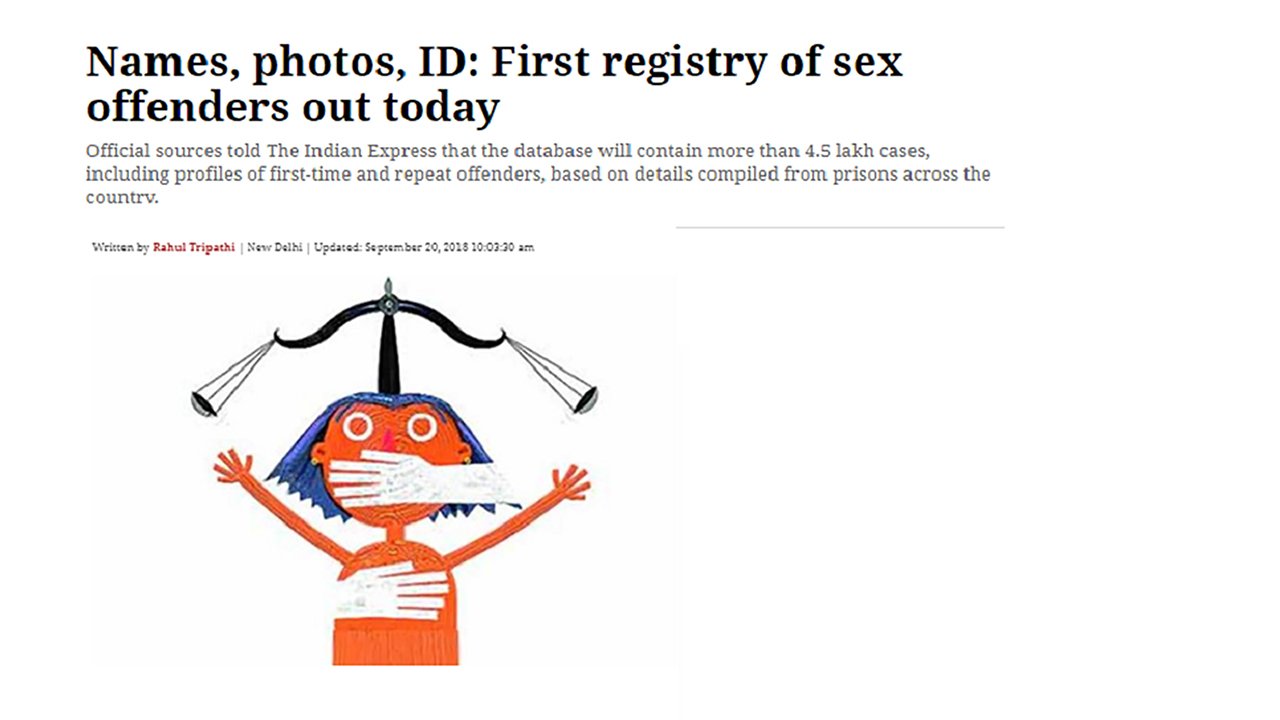The Ministry of Home Affairs, Government of India, has finally come up with what it calls as the National Registry of Sexual Offenders (NRSO). The same is universally commonly called as Sex Offenders’ Registry (SOR) and is combined with a system of notification (N). We had opposed the initial proposal of releasing a public registry of sexual offenders as it had several undesirable elements such as ‘naming, blaming and shaming’, public exposure with dangerous potentiality to lead to street justice and mob lynching. On the other hand, the system offers little utility unlike claimed by its proponents. It also promoted the uncivilized and regressive idea of retributive justice (an eye for an eye).
We, however, strongly recommended a databank on sex offenders (rather on most serious types of criminal offenders) to be accessed discretely by the designated officers from police and judiciary. Going by whatever has been covered in this news item we feel that at the moment there is a reason to give a sigh of relief since the NRSO is on the lines of creating such a databank. The said NRSO will not be publicly accessible. It does not have the notification element either.
However, the current system provides for the inclusion of the persons accused and chargesheeted with sexual offenses in the NRSO, which we think is dangerous. We hope that the government will reconsider this aspect and drop this provision.
– By Dr. Pravin Patkar, Prerana ATC
Date: Thursday, September 20, 2018
Location: Mumbai, Maharashtra, India
India is all set to roll out the National Registry of Sexual Offenders on Thursday, and will become the ninth country in the world to set up and maintain such a database. The Indian registry will include names, photographs, residential address, fingerprints, DNA samples, and PAN and Aadhaar numbers, of convicted sexual offenders.
Official sources told The Indian Express that the database will contain more than 4.5 lakh cases, including profiles of first-time and repeat offenders, based on details compiled from prisons across the country. The offenders will be classified on the basis of criminal history to ascertain if “they pose a serious danger to the community”.
“The database will be maintained by the National Crime Records Bureau (NCRB) under the Ministry of Home Affairs and made available to law enforcement agencies for various purposes, including investigation and employee verification,” a senior government official said.
The registry will be available only to law enforcement agencies in India, unlike in the US where the database maintained by the FBI can be accessed by the public. The registries maintained by other countries — UK, Australia, Canada, Ireland, New Zealand, South Africa and Trinidad & Tobago — are available only to law enforcement agencies.
India’s registry will store data for 15 years in the case of those classified as posing “low danger”, 25 years for those presenting “moderate danger” and through lifetime for “habitual offenders, violent criminals, convicts in gangrape and custodial rapes”, sources said.
The registry will also store information on arrested and chargesheeted offenders but with a clause that limits access to officers with the requisite clearance. Juvenile offenders are likely to be included in the database at a later stage, sources said.
The decision to set up the database was taken in April following nationwide outrage over cases of sexual assault on minors, including the rape and murder of an eight-year-old girl in J&K’s Kathua. The Union Cabinet had subsequently promulgated the Criminal Law Ordinance, 2018, for the death penalty to be handed out to those convicted of raping children below 12 years.
According to NCRB, there has been a three per cent increase in crimes against women and a 12 per cent rise in rapes in 2016, as compared to 2015. As many as 38,947 rape cases were registered in 2016, up from 34,651 in 2015. Overall, cases of crimes against women rose from 3,29,243 in 2015 to 3,38,954 in 2016, according to NCRB.
With the launch of this database, the Government hopes to convey the message ahead of elections next year that the safety of women and children is its top priority. Recently, it set up a National Mission for the Safety of Women, headed by the Union Cabinet Secretary, to undertake specified actions, including setting up Special Fast Track Courts, strengthening forensic facilities, appointing additional public prosecutors, and providing appropriate medical and rehabilitation facilities to victims.
Read The Indian Express (source) article here.






Follow